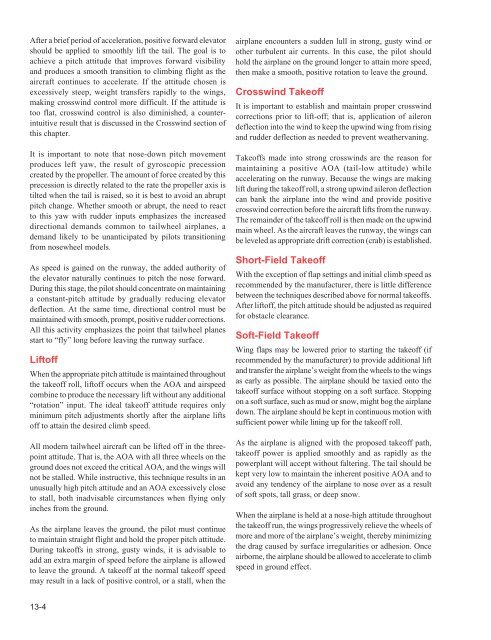Create successful ePaper yourself
Turn your PDF publications into a flip-book with our unique Google optimized e-Paper software.
After a brief period of acceleration, positive forward elevator<br />
should be applied to smoothly lift the tail. The goal is to<br />
achieve a pitch attitude that improves forward visibility<br />
and produces a smooth transition to climbing flight as the<br />
aircraft continues to accelerate. If the attitude chosen is<br />
excessively steep, weight transfers rapidly to the wings,<br />
making crosswind control more difficult. If the attitude is<br />
too flat, crosswind control is also diminished, a counterintuitive<br />
result that is discussed in the Crosswind section of<br />
this chapter.<br />
It is important to note that nose-down pitch movement<br />
produces left yaw, the result of gyroscopic precession<br />
created by the propeller. The amount of force created by this<br />
precession is directly related to the rate the propeller axis is<br />
tilted when the tail is raised, so it is best to avoid an abrupt<br />
pitch change. Whether smooth or abrupt, the need to react<br />
to this yaw with rudder inputs emphasizes the increased<br />
directional demands common to tailwheel airplanes, a<br />
demand likely to be unanticipated by pilots transitioning<br />
from nosewheel models.<br />
As speed is gained on the runway, the added authority of<br />
the elevator naturally continues to pitch the nose forward.<br />
During this stage, the pilot should concentrate on maintaining<br />
a constant-pitch attitude by gradually reducing elevator<br />
deflection. At the same time, directional control must be<br />
maintained with smooth, prompt, positive rudder corrections.<br />
All this activity emphasizes the point that tailwheel planes<br />
start to “fly” long before leaving the runway surface.<br />
Liftoff<br />
When the appropriate pitch attitude is maintained throughout<br />
the takeoff roll, liftoff occurs when the AOA and airspeed<br />
combine to produce the necessary lift without any additional<br />
“rotation” input. The ideal takeoff attitude requires only<br />
minimum pitch adjustments shortly after the airplane lifts<br />
off to attain the desired climb speed.<br />
All modern tailwheel aircraft can be lifted off in the threepoint<br />
attitude. That is, the AOA with all three wheels on the<br />
ground does not exceed the critical AOA, and the wings will<br />
not be stalled. While instructive, this technique results in an<br />
unusually high pitch attitude and an AOA excessively close<br />
to stall, both inadvisable circumstances when flying only<br />
inches from the ground.<br />
As the airplane leaves the ground, the pilot must continue<br />
to maintain straight flight and hold the proper pitch attitude.<br />
During takeoffs in strong, gusty winds, it is advisable to<br />
add an extra margin of speed before the airplane is allowed<br />
to leave the ground. A takeoff at the normal takeoff speed<br />
may result in a lack of positive control, or a stall, when the<br />
airplane encounters a sudden lull in strong, gusty wind or<br />
other turbulent air currents. In this case, the pilot should<br />
hold the airplane on the ground longer to attain more speed,<br />
then make a smooth, positive rotation to leave the ground.<br />
Crosswind Takeoff<br />
It is important to establish and maintain proper crosswind<br />
corrections prior to lift-off; that is, application of aileron<br />
deflection into the wind to keep the upwind wing from rising<br />
and rudder deflection as needed to prevent weathervaning.<br />
Takeoffs made into strong crosswinds are the reason for<br />
maintaining a positive AOA (tail-low attitude) while<br />
accelerating on the runway. Because the wings are making<br />
lift during the takeoff roll, a strong upwind aileron deflection<br />
can bank the airplane into the wind and provide positive<br />
crosswind correction before the aircraft lifts from the runway.<br />
The remainder of the takeoff roll is then made on the upwind<br />
main wheel. As the aircraft leaves the runway, the wings can<br />
be leveled as appropriate drift correction (crab) is established.<br />
Short-Field Takeoff<br />
With the exception of flap settings and initial climb speed as<br />
recommended by the manufacturer, there is little difference<br />
between the techniques described above for normal takeoffs.<br />
After liftoff, the pitch attitude should be adjusted as required<br />
for obstacle clearance.<br />
Soft-Field Takeoff<br />
Wing flaps may be lowered prior to starting the takeoff (if<br />
recommended by the manufacturer) to provide additional lift<br />
and transfer the airplane’s weight from the wheels to the wings<br />
as early as possible. The airplane should be taxied onto the<br />
takeoff surface without stopping on a soft surface. Stopping<br />
on a soft surface, such as mud or snow, might bog the airplane<br />
down. The airplane should be kept in continuous motion with<br />
sufficient power while lining up for the takeoff roll.<br />
As the airplane is aligned with the proposed takeoff path,<br />
takeoff power is applied smoothly and as rapidly as the<br />
powerplant will accept without faltering. The tail should be<br />
kept very low to maintain the inherent positive AOA and to<br />
avoid any tendency of the airplane to nose over as a result<br />
of soft spots, tall grass, or deep snow.<br />
When the airplane is held at a nose-high attitude throughout<br />
the takeoff run, the wings progressively relieve the wheels of<br />
more and more of the airplane’s weight, thereby minimizing<br />
the drag caused by surface irregularities or adhesion. Once<br />
airborne, the airplane should be allowed to accelerate to climb<br />
speed in ground effect.<br />
13-4


